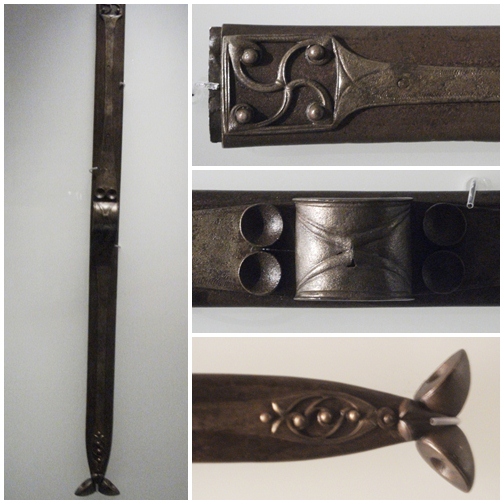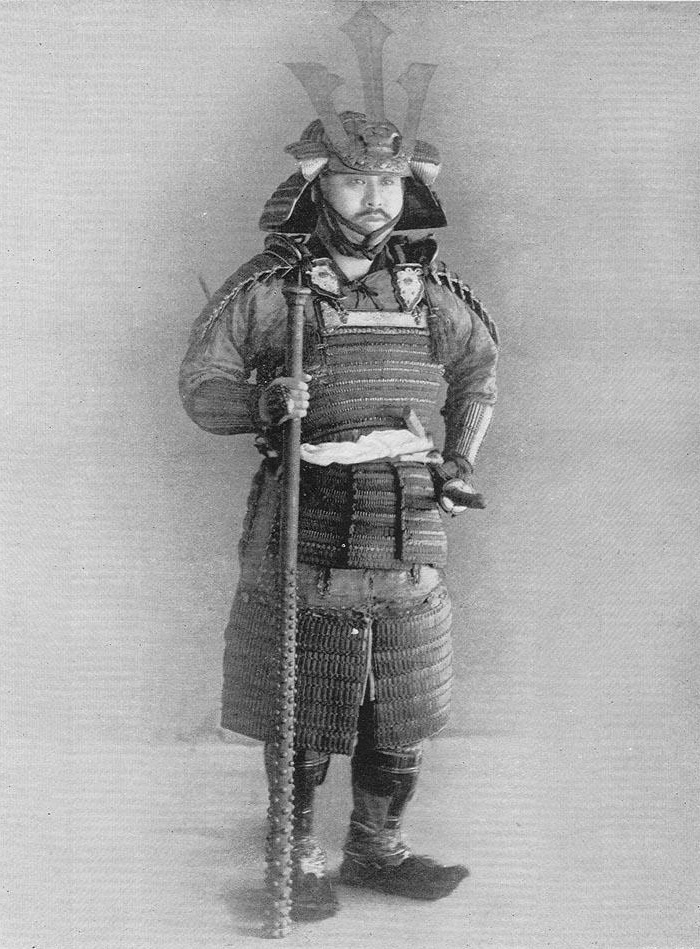|
ōdachi
The (large/great sword) or ''nodachi'' (野太刀, field sword) is a type of traditionally made Japanese sword (日本刀, nihontō) used by the samurai class of feudal Japan. The Chinese equivalent of this type of sword in terms of weight and length is the ''miaodao'', and the Western battlefield equivalent (though less similar) is the ''Zweihänder'' or claymore. The character for ''ō'' (大) means "big" or "great". The ''dachi'' here is the same as , the older style of sword/mounts that predate the ''katana''. The second character in ''tachi'', , is also the same used to spell ''katana'' (刀) and the ''tō'' in ''nihontō'' (日本刀 "Japanese sword"), originally from the Chinese character for a blade, ''dāo''. To qualify as an ''ōdachi'', the sword in question would have a blade length of around 3 ''shaku'' (). However, as with most terms in Japanese sword arts, there is no exact definition of the size of an ''ōdachi''. History In the Nanboku-chō period in t ... [...More Info...] [...Related Items...] OR: [Wikipedia] [Google] [Baidu] |
Japanese Sword
A is one of several types of traditionally made swords from Japan. Bronze swords were made as early as the Yayoi period (1000 BC – 300 AD), though most people generally refer to the curved blades made from the Heian period (794 – 1185) to the present day when speaking of "Japanese swords". There are many types of Japanese swords that differ by size, shape, field of application and method of manufacture. Some of the more commonly known types of Japanese swords are the ''katana'', ''tachi'', '' odachi'', ''wakizashi'', and ''tantō''. Classification Classification by shape and usage In modern times the most commonly known type of Japanese sword is the ''Shinogi-Zukuri'' ''katana'', which is a single-edged and usually curved longsword traditionally worn by samurai from the 15th century onwards. Western historians have said that Japanese katana were among the finest cutting weapons in world military history, for their intended use. Other types of Japanese swords include ... [...More Info...] [...Related Items...] OR: [Wikipedia] [Google] [Baidu] |
Scabbard
A scabbard is a sheath for holding a sword, knife, or other large blade. As well, rifles may be stored in a scabbard by horse riders. Military cavalry and cowboys had scabbards for their saddle ring carbine rifles and Lever action, lever-action rifles on their horses for storage and protection. Scabbards have been made of many materials over the millennia, including leather, wood, and metals such as brass or steel. Most commonly, sword scabbards were worn suspended from a sword belt or shoulder belt called a baldric. Antiquity Wooden scabbards were typically covered in fabric or leather; the leather versions also usually bore metal fittings for added protection and carrying ease. Japanese blades typically have their sharp cutting edge protected by a wooden scabbard called a Japanese sword mountings#Saya, saya. Many scabbards, such as ones the Greeks and Romans used, were small and light. It was designed for holding the sword rather than protecting it. All-metal scabbards were ... [...More Info...] [...Related Items...] OR: [Wikipedia] [Google] [Baidu] |
Sword
A sword is an edged, bladed weapon intended for manual cutting or thrusting. Its blade, longer than a knife or dagger, is attached to a hilt and can be straight or curved. A thrusting sword tends to have a straighter blade with a pointed tip. A slashing sword is more likely to be curved and to have a sharpened cutting edge on one or both sides of the blade. Many swords are designed for both thrusting and slashing. The precise definition of a sword varies by historical epoch and geographic region. Historically, the sword developed in the Bronze Age, evolving from the dagger; the earliest specimens date to about 1600 BC. The later Iron Age sword remained fairly short and without a crossguard. The spatha, as it developed in the Late Roman army, became the predecessor of the European sword of the Middle Ages, at first adopted as the Migration Period sword, and only in the High Middle Ages, developed into the classical arming sword with crossguard. The word '' sword'' continue ... [...More Info...] [...Related Items...] OR: [Wikipedia] [Google] [Baidu] |
Katana
A is a Japanese sword characterized by a curved, single-edged blade with a circular or squared guard and long grip to accommodate two hands. Developed later than the ''tachi'', it was used by samurai in feudal Japan and worn with the edge facing upward. Since the Muromachi period, many old ''tachi'' were cut from the root and shortened, and the blade at the root was crushed and converted into ''katana''. The specific term for ''katana'' in Japan is ''uchigatana'' (打刀) and the term ''katana'' (刀) often refers to single-edged swords from around the world. Etymology and loanwords The word ''katana'' first appears in Japanese in the '' Nihon Shoki'' of 720. The term is a compound of ''kata'' ("one side, one-sided") + ''na'' ("blade"), in contrast to the double-sided '' tsurugi''. See more at the Wiktionary entry. The ''katana'' belongs to the ''nihontō'' family of swords, and is distinguished by a blade length (''nagasa'') of more than 2 ''shaku'', approximately . ' ... [...More Info...] [...Related Items...] OR: [Wikipedia] [Google] [Baidu] |
Tachi
A is a type of traditionally made Japanese sword (''nihonto'') worn by the samurai class of feudal Japan. ''Tachi'' and ''katana'' generally differ in length, degree of curvature, and how they were worn when sheathed, the latter depending on the location of the ''mei'' (銘), or signature, on the tang. The ''tachi'' style of swords preceded the development of the ''katana'', which was not mentioned by name until near the end of the twelfth century. ''Tachi'' were the mainstream Japanese swords of the Kotō period between 900 and 1596. Even after the Muromachi period (1336–1573), when ''katana'' became the mainstream, ''tachi'' were often worn by high-ranking samurai. History The production of swords in Japan is divided into specific time periods: * ''Jōkotō'' (ancient swords, until around 900) * ''Kotō'' (old swords from around 900–1596) * ''Shintō'' (new swords 1596–1780) * ''Shinshintō'' (new new swords 1781–1876) * ''Gendaitō'' (modern or contemporary sw ... [...More Info...] [...Related Items...] OR: [Wikipedia] [Google] [Baidu] |
Naginata
The ''naginata'' (, ) is a pole weapon and one of several varieties of traditionally made Japanese blades (''nihontō''). ''Naginata'' were originally used by the samurai class of feudal Japan, as well as by ashigaru (foot soldiers) and sōhei (warrior monks). The naginata is the iconic weapon of the onna-musha, a type of female warrior belonging to the Japanese nobility. Naginata for fighting men and warrior monks were ''ō-naginata'' (大薙刀). The kind used by women were called ''ko-naginata'' (小薙刀). Description A ''naginata'' consists of a wooden or metal pole with a curved single-edged blade on the end; it is similar to the Chinese guan dao or the European glaive. Similar to the katana, naginata often have a round handguard (''tsuba'') between the blade and shaft, when mounted in a koshirae (furniture). The 30 cm to 60 cm (11.8 inches to 23.6 inches) ''naginata'' blade is forged in the same manner as traditional Japanese swords. The blade has a long tang ... [...More Info...] [...Related Items...] OR: [Wikipedia] [Google] [Baidu] |
Kanabō
The (literally "metal stick" or "metal club") is a spiked or studded two-handed war club used in feudal Japan by samurai. Other related weapons of this type are the ''nyoibo'', ''konsaibo'', , and ''ararebo''.Mol, Serge (2003). ''Classical weaponry of Japan: special weapons and tactics of the martial arts''. Kodansha International. p. 91. Related solid iron weapons with no spikes or studs are the ''kanemuchi'' (or ''kanamuchi'') and the ''aribo'' (also known as a ''gojo'' or ''kirikobo''). Description ''Kanabō'' and other related club-like weapons were constructed out of heavy wood or made entirely from iron, with iron spikes or studs on one end. For wooden ''kanabō'', one or both ends could be covered with iron caps. ''Kanabō''-type weapons came in all manner of shapes and sizes, with the largest ones being two-handed and as tall as a man, while smaller ones were primarily one-handed and the length of a forearm. Their shape could be similar to that of a baseball bat, ... [...More Info...] [...Related Items...] OR: [Wikipedia] [Google] [Baidu] |
Yari
is the term for a traditionally-made Japanese blade (日本刀; nihontō) in the form of a spear, or more specifically, the straight-headed spear. The martial art of wielding the is called . History The forerunner of the is thought to be a derived from a Chinese spear. These are thought to be from the Nara period (710–794). The term appeared for the first time in written sources in 1334, but this type of spear did not become popular until the late 15th century. The original warfare of the was not a thing for commoners; it was a ritualized combat usually between two warriors who would challenge each other via horseback archery. In the late Heian period, battles on foot began to increase and , a polearm, became a main weapon along with a ''yumi'' (longbow).Basic kno ... [...More Info...] [...Related Items...] OR: [Wikipedia] [Google] [Baidu] |
:Category:Japanese Words And Phrases
{{Commons Words and phrases by language Words Words A word is a basic element of language that carries an objective or practical meaning, can be used on its own, and is uninterruptible. Despite the fact that language speakers often have an intuitive grasp of what a word is, there is no consen ... Words ... [...More Info...] [...Related Items...] OR: [Wikipedia] [Google] [Baidu] |
Samurai Wearing A Nodachi (field Sword)
were the hereditary military nobility and officer caste of medieval and early-modern Japan from the late 12th century until their abolition in 1876. They were the well-paid retainers of the '' daimyo'' (the great feudal landholders). They had high prestige and special privileges such as wearing two swords and ''Kiri-sute gomen'' (right to kill anyone of a lower class in certain situations). They cultivated the '' bushido'' codes of martial virtues, indifference to pain, and unflinching loyalty, engaging in many local battles. Though they had predecessors in earlier military and administrative officers, the samurai truly emerged during the Kamakura shogunate, ruling from 1185 to 1333. They became the ruling political class, with significant power but also significant responsibility. During the 13th century, the samurai proved themselves as adept warriors against the invading Mongols. During the peaceful Edo period (1603 to 1868), they became the stewards and chamberlains of ... [...More Info...] [...Related Items...] OR: [Wikipedia] [Google] [Baidu] |
Muromachi Period
The is a division of Japanese history running from approximately 1336 to 1573. The period marks the governance of the Muromachi or Ashikaga shogunate (''Muromachi bakufu'' or ''Ashikaga bakufu''), which was officially established in 1338 by the first Muromachi ''shōgun'', Ashikaga Takauji, two years after the brief Kenmu Restoration (1333–1336) of imperial rule was brought to a close. The period ended in 1573 when the 15th and last shogun of this line, Ashikaga Yoshiaki, was driven out of the capital in Kyoto by Oda Nobunaga. From a cultural perspective, the period can be divided into the Kitayama and Higashiyama cultures (later 15th – early 16th centuries). The early years from 1336 to 1392 of the Muromachi period are known as the '' Nanboku-chō'' or Northern and Southern Court period. This period is marked by the continued resistance of the supporters of Emperor Go-Daigo, the emperor behind the Kenmu Restoration. The Sengoku period or Warring States period, which begi ... [...More Info...] [...Related Items...] OR: [Wikipedia] [Google] [Baidu] |









